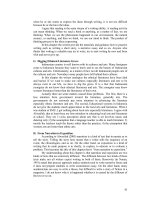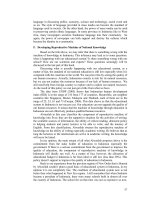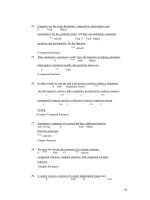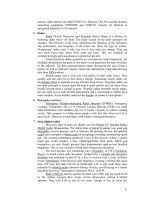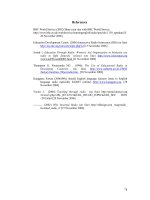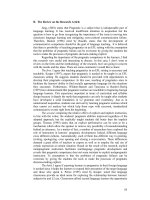Teaching and learning English vocabulary through short stories in some primary schools in Vinh=Dạy và học từ vựng tiếng Anh qua những câu chuyện ngắn trong một số trường Tiểu học ở Vinh
Bạn đang xem bản rút gọn của tài liệu. Xem và tải ngay bản đầy đủ của tài liệu tại đây (1.37 MB, 87 trang )
MINISTRY OF EDUCATION AND TRAINING
Vinh university
==========
TĂng thỊ THOA
TEACHING AND LEARNING ENGLISH VOCABULARY
THROUGH SHORT STORIES IN SOME PRIMARY
SCHOOLS IN VINH
(DẠY VÀ HỌC TỪ VỰNG TIẾNG ANH QUA NHỮNG CÂU CHUYỆN NGẮN
TRONG MỘT SỐ TRƯỜNG TIỂU HỌC Ở VINH)
MASTER thesis IN EDUCATION
Nghe An, 2013
MINISTRY OF EDUCATION AND TRAINING
Vinh university
==========
TEACHING AND LEARNING ENGLISH VOCABULARY
THROUGH SHORT STORIES IN SOME PRIMARY
SCHOOLS IN VINH
(DẠY VÀ HỌC TỪ VỰNG TIẾNG ANH QUA NHỮNG CÂU CHUYỆN NGẮN
TRONG MỘT SỐ TRƯỜNG TIỂU HỌC Ở VINH)
FIELD: THEORY AND MOTHODOLOGY OF ENGLISH LANGUAGE TEACHING
CODE : 60.14.10
MASTER thesis IN EDUCATION
SUPERVISOR: Assoc.Prof.Dr. TRUONG VIEN
Nghe An, 2013
MINISTRY OF EDUCATION AND TRAINING
Vinh university
==========
TĂng thỊ THOA
TEACHING AND LEARNING ENGLISH VOCABULARY
THROUGH SHORT STORIES IN SOME PRIMARY
SCHOOLS IN VINH
(DẠY VÀ HỌC TỪ VỰNG TIẾNG ANH QUA NHỮNG CÂU CHUYỆN NGẮN
TRONG MỘT SỐ TRƯỜNG TIỂU HỌC Ở VINH)
MASTER thesis IN EDUCATION
Nghe An, 2013
Acknowledgements
I would like to express my deep thanks to my supervisor, Dr. Truong
Vien, who has helped me a lot with his advice, directions, comments, criticism
and encouragement for the accomplishment of this study.
I am also grateful to all teachers in the foreign languages department
for their helpful advice and valuable lectures from which I benefited a lot in
writing this study.
I also feel beholden to teachers and students from Le Loi primary
school, Doi Cung primary school, Quang Trung primary school, Ha Huy Tap
primary school, Le Mao primary school, Cua Nam primary school.
I wish to express my special thanks to Ms. Dinh Thi Yen for her
suggestions of the study.
I also really want to express my profound thanks to my family, my friends
whose ideas, support and source of materials were great importance to me in
carrying out this study.
Finally, my sincere thanks are due to all classmates who gave me some
comments after reading my graduation thesis. Many thanks to all of them.
I will always keep thanks!
Vinh, 2013
Tang Thi Thoa
ABSTRACT
The study “Teaching and learning vocabulary through short stories in
some primary schools in Vinh” has implemented with a view to investigate the
way how teach vocabulary to primary students in Vinh in an effective method.
The study also aimed to indentify the teachers and students’ perceptions and
reaction towards teaching and learning new words through short stories.
The subjects of the research concluded teachers and 4 th and 5th grade
students in six primary schools in Vinh. The two data collection methods used
in this study were the questionnaire and interviews. The questionnaires were
given to teachers who have taught English in Vinh primary schools. These
teachers were interviewed afterwards so as to investigate their perceptions
towards teaching and learning through short stories. Students were interviewed
under the researcher’s clear instructions and assistance.
Some main findings consisted teachers’ and learners’ perceptions
towards vocabulary in language learning, towards features of vocabulary,
towards vocabulary teaching and consolidation techniques and towards
necessity of teaching vocabulary through short stories. Both teachers and
learners were aware of significance of vocabulary. In addition, some
perception on features of vocabulary were revealed, which were highly taken
consideration in teaching vocabulary. Lastly, the results from the
questionnaire and interviews have show a number of teaching vocabulary
techniques which excite students and produce effectiveness on remembering
vocabulary in the long run. The researcher also concluded some implications
to improve the teaching and learning vocabulary in primary schools at
present time. The suggestions were put forward the benefit of teachers,
administers and students.
There are still a number of shortcomings in the study. However, it has
been implemented with all my efforts, interests and inspiration.
In general, the thesis has been conducted with the purpose of handing
teachers and students of English some useful knowledge about vocabulary. It
is hard for the author to deal with everything about them but hopefully, the
thesis has introduced something new, creative and advantageous for teaching
and learning vocabulary in primary school.
TABLE OF CONTENTS
ACKNOWLEDGEMENTS
ABSTRACT
TABLE OF CONTENTS
CHAPTER 1. INTRODUCTION
1.1. The Reasons for choosing the study
1.2. The Aims of the Study
1.3. The Scope of the Study
1.4. The Design of the Study
CHAPTER 2. LITERATURE REVIEW
2.1. Definition of vocabulary and its importance
2.2. Perspectives of knowing a word
2.3. Vocabulary teaching
2.3.1. The importance of teaching vocabulary
2.3.2. Teaching Vocabulary to children
2.3.3. Teaching vocabulary through short stories to children
2.3.4. The characteristics of from 8 to 12 years old
2.3.5. Aspects of vocabulary to be taugh
2.4. Vocabulary and context
2.4.1. Teaching vocabulary in context
2.4.2. Teaching guessing meaning from context
2.5. Techniques for presenting vocabulary
2.5.1. Presentation
2.5.2. Discovery techniques
2.5.3. Practice
2.6. Techniques of consolidating vocabulary
2.7. The value of short stories
2.7.1. Concept of stories
2.7.2. The benefits of using stories
CHAPTER 3. METHODOLOGY
3.1. The research questions
3.2. Research design
3.3. Participant and research sites
3.4. Research instruments for data collection
3.4.1. The questionnaire for teachers
3.4.2. The interviews
3.5. Procedure of the study
3.5.1. Administrating the questionnaire
3.5.2. Administrating the interviews
3.6. Conclusion
CHAPTER 4. FINDINGS AND DISCUSSION
4.1. Data analysis from teacher questionnaires
4.1.1. Teachers’ perceptions towards vocabulary in language learning
4.1.2. Teachers’ perceptions towards features of vocabulary
4.1.3. Teachers’ perceptions towards vocabulary teaching and consolidation
techniques
4.1.4. Teachers’ perceptions towards necessity of teaching vocabulary through
reading short stories
4.2. Data analysis from teacher interviews
4.2.1. Teachers’ perceptions towards vocabulary in language learning
4.2.2. Teachers’ perceptions towards vocabulary teaching and consolidation
techniques as well as difficulties faced in the procedure
4.2.3. Teachers’ perceptions towards necessity of teaching vocabulary through
reading short stories
4.3. Data analysis from student interviews
4.3.1. Learners’ perception towards learning vocabulary
4.3.2. Learners’ perception towards presenting vocabulary technichques
used
in language class
4.4. Discussion
4.4.1. Theoretical framework of the study
4.4.2. Discussion on the findings
4.4.2.1. Findings on the teacher s’ and learners’ perceptions towards vocabulary
in language learning
4.4.2.2. Findings on the teachers’ perceptions towards features of vocabulary
4.4.2.3. Findings on the teachers’ perceptions towards vocabulary teaching and
consolidation techniques
4.4.2.4. Findings on the teachers’ perceptions towards necessity of teaching
vocabulary through Short stories
CHAPTER 5. CONCLUSION AND IMPLICATIONS
5.1. Research questions revisited
5.1.1. Research question 1
5.2.1.Research question 2
5.2. Implications
5.2.1. For teachers
5.2.2. For administers
5.2.3. For students
5.3. Limitation
BIBLIOGRAPHY
APPENDICES
CHAPTER 1
INTRODUCTION
1.1. The reasons for choosing the study
In the course of global integration, English has become the vital device
for communication in all fields. It is acting as a bridge which brings people from
different countries in the world closer together. Therefore, human beings
appreciated the role of English more and more .
English has been considered to be the most necessary subject for students
in all levels of educational systems. The demand of learning English is gradually
increasing. To meet the need of everybody, education is required to be improved,
how to find the most effective method in teaching English is the concern now.
Open-door policy of many countries’ governments has been giving people many
chances to learn and practise English. Nowadays, people all over the world learn
English; therefore, English has become necessary for a lot of people at different
social positions. Being aware of its importance, Ministry of Education and
Training announced the decision that English has been experimented as a
compulsory subject in primary schools.
As a matter of fact, teaching English at the beginning level is extremely
important because it is seen as the foundation for the higher levels in the future.
Many researchers present some reasons for teaching English at primary levels
including Brewster, Ellis, and Grard ( 1992 ). They say that the aim of early
foreign language learning is to prepare young learner linguistically,
psychologically, and culturally for language learning (p.23-2). The justification
of Singleton in Brumfit ( 1997 ) for this matter is “ the need for maximum
learning time for important languages the earlier you start the more time you
get” (p7). In brief, teaching English language to primary students is very
essential. It can give them linguistical, psychological and cultural preparation
for language learning. It also increases the number of years learning foreign
language, the more they learn the more they get.
At the beginning level, primary teachers often put emphasis upon teaching
vocabulary which is viewed as the “ building blocks” of learning any language.
The more they understand what they hear and the better they express
themselves. However, primary students’ vocabulary acquisition is often
approached through memorizing decontextualized word lists. There are two
serious consequences when students learn vocabulary by the above method. The
first problem relating to young learners’ characteristic, that is, they forget
something very quickly. Writing down the correct words or group words is
another students’ trouble. Learning new words by memorizing decontextualized
word lists shows a complete contrast to the concept that “most vocabulary is
acquired from context” ( Sternberg,1987). In addition, children can learn words
from written contexts ( Nagy et al., 1985, Mckeown, 1985) (as cited in Aist,
2002).
Due to the facts above, it raises the issue how to teach and learn new
words for primary students in a contextual way. In fact, short stories can help to
solve these problems because it meets the primary need: context. The idea that
students can learn through reading short stories is attractive for many reasons.
Short stories are kinds of interesting materials that help students learn and
remember vocabulary in long term. Moreover, because of the words are inside
the text, students can remember the way how to write down the words correctly.
For the reasons as above, I have decided to choose the topic : TEACHING
AND LEARNING VOCABULARY THROUGH SHORT STORIES IN SOME
PRIMARY SCHOOLS IN VINH.
1.2. The Aims of the Study
For the reasons mentioned above, the thesis has been done with the wish
that it can contribute to the improvement in teaching English in general and in
teaching vocabulary in primary schools. The thesis aims to :
- Present some general knowledge about vocabulary.
- Give some features of the situation of teaching and learning vocabulary in
primary school.
- Help teachers and students be aware of the role of teaching and learning
vocabulary.
- Help students learn and remember vocabulary in long term.
- Raises the issue how to teach and learn new words for primary students in
a contextual way.
- Suggest some activities for teaching and learning vocabulary in primary
school.
1.3. The Scope of the Study
Investigates the necessity of teaching and learning vocabulary from
written contexts as well as to identify the teachers and students’ perceptions and
reactions towards teaching and learning new words through short stories,
entitled “TEACHING AND LEARNING VOCABULARY THROUGH SHORT
STORIES IN SOME PRIMARY SCHOOL IN VINH”. The research is aimed at
solving the following questions.
1. What are teachers’ and students’ perceptions about using short stories
to teach and learn vocabulary in primary school?
2. How do teachers and students deal with the teaching and learning
of vocabulary through short stories in primary school?
1.4. The Design of the Study
The study consists of 5 chapters:
Chapter I. Introduction
This part will introduce the problem leading to the study, purpose, scope,
and organization of the study.
Chapter II. Literature review
Chapter III. Methodology
Chapter IV. Findings and discussion
Chapter V. Conclusion and Implication
CHAPTER 2
LITERATURE REVIEW
2.1. Definition of vocabulary and its importance
There are a lot of definitions of vocabulary given by linguist. According
to Hatch and Brown ( 1995), vocabulary is a list or a set of words for a
particular language or set of words that individual speakers of a language might
use (p.1). This means the only system involved here is alphabetical order in
dictionaries. It can be concluded from Hatch and Brown’s perception on
vocabulary is that vocabulary is written in alphabetical order in dictionaries
based on system or rule of foreign language.
Also, Ur (1989) roughly defines vocabulary as “the words we teach in the
foreign language” (p.60). It implies that vocabulary is written or spoken unit of
languages as symbol of idea in foreign language. For instance, if someone
learns new words in foreign, it means that someone learns vocabulary. The
items in vocabulary may be more than a single word, for example post office
mother-in-law, which expressing a single idea.
Furthermore, Mc Whorter ( 1989) states that vocabulary deals with the
competence in recognizing individual words and in associating meaning with
the particular combination of letters that form a word (p.331). Words are
symbols, groups of letter that stand for either a physical object or an idea. Then,
recognising words means working its meaning or idea and how they are formed
by a combination of letters. For example, the word chair in our minds a physical
reality, an object with a flat surface, supported by four legs and used to for
sitting. On the other hand, the word love does not represent a physical object. It
symbolises someone’s strong feeling of affection towards another.
Based on the three definitions above, vocabulary can be constructed as a
series of words in foreign language used to express meaning. The words are the
symbol in form of groups of letters either a physical object or an idea. It can be
formed from a single or more than one word.
The status of vocabulary within the curriculum has varied considerably
over these years. During the 1950s and 1960s when audio-lingualism had a
dominant influence on methodology, vocabulary suffered significant neglect but
made something of a comeback during the 1970s under the influence of
communicative language teaching. As a matter of fact, there is now general
agreement among vocabulary specialists that lexical competence is as the very
heart of communication competence, the ability to communicate successfully
and appropriately ( Coady and Huckin, 1979, cited in Decarrico, 2001, p. 285).
For much of this century, the principal focus of the traditional GrammarTranslation Method in ELT for years on a balanced diet of grammar and
vocabulary has primarily brought about the low status of vocabulary. The
Audio-Lingual Method was applied in ELT afterwards and was considered
better than Grammar- Translation Method in terms of using the target language.
However, audio-lingualists suggested that the emphasis should be strongly on
the acquisition of the basic grammatical patterns, and then building a large
vocabulary could come later (Nunan, 1991, p.117). It can be easily seen that the
role of vocabulary in these days was inferior to that of grammar.
Only when the concept of communicative competence which focused
using language for meaningful communication appeared and communicative
Approach was introduced in ELT, “vocabulary teaching was coming in to its
own” (Decarrico, 2001, p. 286) and the status of vocabulary has been
considerably enhanced. As cited in Nunan (1991), Hockette (1985) stated that
vocabulary was the easiest aspect of second language learning. The
comprehensive-based methods such as the Natural Approach (Krashen and
Terrell, 1983) whose proponents pointed out that in the early stages of learning
and using a second language one it better served by vocabulary than grammar
and that one can ‘bypass’ grammar in going for meaning if one has a reasonable
vocabulary use. Rivers (1983) indicated that the acquisition of an adequate
vocabulary was essential for successful second language use (p.125). He also
set out the reasons including the important explanation, it was, without
vocabulary we would be unable to use the structures and functions we may have
learnt for comprehensive communication (p. 117, as cited in Nunant, 1991).
These day, the consensus of opinion seems to be the growth of rich
vocabulary is an indispensable element in the acquisition of the second language.
Since then, methodologists and linguists have increasingly been turning their
attention to vocabulary, stressing its importance in language teaching and
reassessing some ways in which it is taught and learnt. The problem in teaching
vocabulary lie in the questions what it means to know a word and how to select
what word to teach English.
2.2. Perspectives of knowing a word
As Hendrich informs vocabulary forms the naming part of communicative
act. From the didactic point of view it is essential to count with it as with a
component which adoption is mostly a question of memory. In every case
the lexicon is a basic element of a language from both communicative and
language methodological point of view. (Hendrich 1988:130) In action with
word list the language methodological and psychological viewpoints are
applied. Language methodology gives us at disposal mostly results of 10
statistical researches with figures of frequency and distribution of terms both
generally, in speech, in written form, or in different styles. These figures
serve well for basis of effective foreign language vocabulary choice and
practice. Psychology gives us valuable suggestions how to acquire and
remember a foreign language lexicon optimally and how to practise the
voluble use of this lexicon in communicative process.
Besides, psychology teaches us the importance and utilization of
motivation and how to overcome difficulties when acquiring a foreign language.
(Hendrich 1988:130)
Hendrich divides vocabulary of an individual as both active, meaning
productive, and passive, meaning receptive. This discrimination is
purposeful particularly when teaching foreign languages because words that
learners have to acquire actively have to be served and practised differently
than those words that are intended for receptive adoption. (Hendrich
1988:130)
Also Scrivener points out that the important consideration for teachers
planning vocabulary work is the distinction between productive and
receptive vocabulary. He explains the disctinction between them that people
understand many more words than they actually use in everyday situations,
and that receptive vocabulary is the set of words that people recognize and
understand, but tend not to use themselves. (Scrivener 1994:74)
Acquiring active word list is sometimes considered to be the most difficult
task when learning a foreign language. According to some methodologists
active mastering of a foreign language subject matter is substantially more
difficult than passive mastering. (Hendrich 1988:131)
According to Hendrich, vocabulary classification is possible to
maintain from different viewpoints: formal (for example word classes);
mechanical (alphabeticaly, or according to the frequency); semantic, that is
according to the relationships of language marking to off-language reality or
according to the relationships of meaning (synonyms, antonyms, etcetera); or
from the grammatical viewpoint, mainly paradigmatic, which is grouping words
together according to the same grammatical characteristics. (Hendrich
1988:131)
It is obvious that the various facets of knowing a word should be complete
considered. Some people believe that vocabulary knowledge consists of simple
two facets- meaning and word form. But the potential knowledge can be know
about a word is rich and complex. Nation (1990:31) proposes the following list
of the different kinds of knowledge that a person must master so as to know a
word.
• The meaning(s) of the word
• The written form of the word
• The spoken form of the word
• The grammatical behavior of the word
• The collocations of the word
• The register of the word
• The association of the word
• The frequency of the word
Another perception on knowing a word is (1) knowing its pronunciation
and stress; (2) knowing its spelling and grammatical properties; (3) knowing its
meaning; (4) knowing how and when to use it to express the intended meaning
(Wang, 2006, p.118).
In a much clearer and more detailed way, Harmer (1991, p. 158)
concludeds “Knowing a word” in the following way:
WORDS
MEANING
WORD USE
Meaning in
Metaphor and
context
Idioms
WORD
WORD
INFORMATION
GRAMMAR
Parts of speech
Nouns
Prefixes
Sense relations
Collocations
Style and register
and
suffixes
Verbs
Complementation
Spelling
Adjectives
and
and
pronunciation
adverbs
What has been discussed so far is to clarify that knowing a word means
much more than just understanding its meaning(s), Thus, teachers somehow
must help students to understand what this knowledge implies both in general
and for certain words in particular. By being aware students will be more
receptive to the contextual behavior of words when they first see them in texts
and they will be better able to manipulate both the meanings and forms of the
word.
2.3. Vocabulary teaching
2.3.1. The importance of teaching vocabulary
"If language structures make up the skeleton of language, then it is
vocabulary that provides the vital organs and the flesh" (Jeremy Harmer). An
ability to manipulate grammatical structure does not have any potential for
expressing meaning unless words are used. We talk about the importance
"choosing words carefully" in certain communications, but we are less concerned
about choosing structures carefully, unless of course we are in a language
classroom. Then structural accuracy seems to be the dominant focus. In real life,
however, it is possible that where vocabulary is used correctly, it can cancel out
structural inaccuracy, but communication's purpose is still achieved.
However, for many years in the past, the importance of vocabulary
teaching was not appreciated. Vocabulary was just seen as incidental to the
main purpose of language teaching - namely the acquisition of grammatical
knowledge about the language. Vocabulary was necessary to give students
something to hang on to when learning structures, but was frequently not a main
focus for learning itself.
Recently, in the highlight of Communicative Approach, the
importance of vocabulary teaching is highly appreciated. Methodologists and
linguists have increasingly been turning their attention to vocabulary, stressing its
importance in the language teaching and reassessing some of the ways in which
it is taught and learnt. It is, now, clear that the acquisition of grammar - though
the two are obviously interdependent - and teachers should have the same kind of
expertise in the teaching of vocabulary as they do in the teaching of structure.
2.3.2. Teaching Vocabulary to children
Though each child learns at different speeds and often in very different
ways, experts, as well as many teachers, find that there are many similarities of
the learning characteristics among certain age groups. These similarities can
form the basis of teaching styles and education curriculum.
Teaching English to children is definitely different from that to adult.
Owing to their unique characteristics, children have a greater need to be
motivated and activities to learn effectively.
Because vocabulary knowledge is critical to reading
comprehension, it is important that those working with young readers help foster
their development of a large “word bank” and effective vocabulary learning
strategies. There are several effective explicit (intentional, planned instruction)
and implicit (spontaneous instruction as a child comes to new words in a text).
Some strategies that teacher can teach vocabulary to children
• Pre-teaching Vocabulary Word
One of the most effective methods of helping children learn new
vocabulary words is to teach unfamiliar words used in a text prior to the reading
experience. Teachers (either alone or with the children) should preview reading
materials to determine which words are unfamiliar. Then these words should be
defined and discussed. It is important for the teachers to not only tell the
children what the word means, but also to discuss its meaning. This allows the
children to develop an understanding of the word’s connotations as well as its
denotation. Also, discussion provides the teacher with feedback about how well
the children) understands the word. After pre-teaching vocabulary words, the
children should read the text.
• Repeated Exposure to Words
It may seem common sense that the more times we are exposed to a word,
the stronger our understanding becomes. However, repeated exposure to new
vocabulary words is often ignored. Teacher often forget a person (especially a
child) needs to hear and use a word several times before it truly becomes a part
of her vocabulary. Providing multiple opportunities to use a new word in its
written and spoken form helps children solidify their understanding of it.
• Keyword Method
Like pre-teaching, the keyword method occurs before a child reads a
particular text. In this method, unfamiliar words are introduced prior to reading.
However, rather than encouraging the child to remember a definition for a new
word, the teacher teaches him a “word clue” to help him understand it. This
“word clue” or keyword might be a part of the definition, an illustrative example
or an image that the children connects to the word to make it easier to remember
the meaning when reading it in context. The idea behind the keyword method is
to create an easy cognitive link to the word’s meaning that the children can
access efficiently during a reading experience.
• Restructuring Reading Materials
This strategy is particularly effective for helping struggling children
improve their vocabularies. Sometimes grade level materials are inaccessible to
children because there are too many unfamiliar words in them. Teacher can
restructure the materials in several different ways to help children comprehend
them more easily. A portion of the difficult words can be replaced with “easier”
synonyms to help the children understand the overall text. Vocabulary footnotes
(definitions provided at the bottom of the page) can be added for particularly
challenging words so that the children can easily “look up” the word while still
reading the text. An accompanying vocabulary guide can be provided for the
text. Words that are included in the guide should be highlighted or printed in
bold text to direct the children to check the vocabulary guide if the word or its
meaning is unfamiliar.
• Incidental Learning
Incidental vocabulary learning occurs all of the time when we read. Based
on the way a word is used in a text we are able to determine its meaning. While
you may not know what a specific word means, many times you can determine
its meaning based on what the rest of the sentence focuses on. Teachers should
model this sort of incidental vocabulary learning for children to help them
develop their own skills.
• Context Skills
Context skills are the strategies that a child uses for incidental vocabulary
learning. Texts are full of “clues” about the meanings of words. Other words in a
sentence or paragraph, captions, illustrations and titles provide children with
information about the text that they can use to determine the meanings of
unfamiliar words. These features are often referred to as “context clues” because
they are contained within the context of the piece of writing rather than outside
it. Children should be taught to find and use context clues for learning new
vocabulary words. Teacher modeling and practice are key for helping children
develop this important vocabulary skill.
2.3.3. Teaching vocabulary through short stories to children
The notion that the main objective of EFL teaching is to help students to
communicate fluently in the target language cause most teachers still believe that
an EFL class should focus on mastering linguistic elements only. However,
recent trend in EFL teaching indicates the necessity of integrating literature
because its rich potential to provide an authentic model of language use. Among
literary genres, short stories seem to be the most suitable choice for this due to its
potential to help students enhance the four skills listening, speaking, reading and
writing more effectively because of the motivational benefit embedded in the
stories. As a teacher using a story in the classroom, there are many ways of
using and exploiting the stories to help children understand and add to their
enjoyment.
Short stories are one of suitable literary genre to use in English teaching due
to its shortness, is supported by Collie and Slater (1991: 196) when they list four
advantages of using short stories for language teachers. First, short stories are
practical as their length is long enough to cover entirely in one or two class
sessions. Second, short stories are not complicated for students to work with on
their own. Third, short stories have a variety of choice for different interests and
tastes.
The use of short-story in English teaching should be aimed to
encourage the students to use what they have previously learnt. By doing this, the
learning process will be student-centered. However, the teacher plays a great
role. She/he must choose a suitable text to use in class, and should help her/his
students understand the story with various activities.
In using short stories to teach English, story selection is indeed one of the
most important roles of the teacher. Since the lengths of short-stories quite vary,
choose a story short enough to handle within course hours. The shortness of the
text is important for the students because they will see that they can read,
understand and finish something in English, and it will give the students a feeling
of achievement and self-confidence.
Vocabulary and sentence structure of the short-story to be studied must be
suitable to the level of the students. The short-stories with archaic, slang, foreign
words, and allusions, having sentences imitating the speech of a particular
locality or ignorant people or foreigners should be avoided if the text is intended
for students below intermediate level. Similarly, very long sentences are difficult
for students to understand. As students will not understand these sentences and
words, they will get bored and not read the work. Therefore, before giving the
short-story, the teacher should decide the readability of the text.
In order to meet that readability criterion, using graded or simplified stories
is possibly the most practical way. According to Ur (1996: 150), “… the use of
‘authentic’ text with less proficient learners is often frustrating and counterproductive”. Therefore, the use of simplified text with less proficient readers is
highly suggested for the sake of suiting the texts with the level of students. Spack
(1985) suggests the aspect of interest to be considered. According to him, it is
important for the teacher to choose stories that would interest students that he/she
most likes to read and teach, and that have been made into film to provide visual
interpretation. McKay (2001: 322) and Rivers (1968: 230) point out that students
read and enjoy a text if the subject-matter of the text is relevant to their life
experience and interests.
Short stories allow teachers to teach the four skills to all levels of language
proficiency. Murdoch (2002: 9) indicates that “short stories can, if selected and
exploited appropriately, provide quality text content which will greatly enhance
ELT courses for learners at intermediate levels of proficiency”. According to
him, short stories could be very beneficial materials in ELT reinforcement by
using them in learning activities such as, discussion, writing and acting out
dialogues.
2.3.4. The characteristics of children from 8 to 12 years old
As with the younger age group, 8- to 12-year-olds will still benefit most
from learning by seeing and doing simultaneously. Their active nature means
they are likely to absorb more information in a hands-on environment.
Making vocabulary practice exciting is important for 4 th and 5th graders to
reinforce their regular vocabulary lessons. Teaching and learning vocabulary
through short stories help cultivate students’ interest in learning by giving them
the opportunity to practice vocabulary concepts in a fun way. They can practice
vocabulary word lists, reinforcing the concepts of syllables, compound words,
contractions, parts of speech, spelling and word meaning as well as continuing a
pattern of vocabulary building by learning about antonyms, synonyms and
homonyms, root words, suffixes, prefixes, homophones and word meaning.
The study focuses on the 4 th and 5th graders who have the following
characteristics according to Clark(1990):
They are developing conceptually. They develop their way of thinking
from the concrete to the abstract thing. Teachers should bear in mind the
distinctiveness so as to apply in language teaching to children. They are
developing their common skills such as turn taking and the use of body language
and they learn slowly. They get bored easily so that the class activities should be
fun and interesting. They are better mimics. It will take them more confident in
attempting the sound of foreign language. They forget quickly. Therefore,
teachers need some techniques to teach vocabulary effectively and revise them
properly ( Clark, 1990, as cited in Scott and Ytrberg, 1990, pp. 6-8).
In addition, their general concepts are formed and they are learning to read
and write in their own language and somehow become competent users of their
mother tongue. It will be too hard to investigate the English vocabulary learning
of 6-year-old students who have just been taught the Vietnamese alphabet.
Second, 4th and 5th graders are developing as thinkers, which make it easy when
they threat a text (Slattery, M. and Willis, J.,2001). Regarding to their language
development, by the end of ten, students can understand a bit abstracts,
understand symbols beginning with words and generalise and systematise ( Scott
and Ytrberg, 1990, pp. 3-4).
It can be conclude that teachers need suitable approaches , exciting
activities and ways to motivate students based on their characteristics in teaching
English in general and teaching vocabulary.
2.3.5. Aspects of vocabulary to be taught
When learning a new subject, the basic material must be learned before it
becomes possible to understand more complicated information. The simplest
information is how we talk about a topic, or the vocabulary needed to discuss it.
Once that is mastered, it becomes easier to build upon the information to talk
about more complex ideas and think more critically about what is being taught.
There is a bit different from teaching vocabulary and presenting vocabulary.
Teaching vocabulary is obviously more than just presenting new words. This may
have its places but there are other issues. For example, there are lots of words
which students have to learn during a week. Some of them are used straight
away, others are not. Some words should be taught for structure practice and so
on. Let us look at “ Active and passive” to get deeper understanding about active
and passive vocabulary as well as to decide which words should be taught for
students.
In teaching and learning vocabulary, it is necessary to be aware of a
distinction between active or productive and passive or receptive vocabulary.
Different researchers have different point of views about active and passive
vocabulary. Wang,(2006) defines passive/ receptive vocabulary as words which
one is able to recognize and comprehend in reading and listening but unable to
use automatically in speaking or writing. Those words that one is not only able to
recognize but also able to use in speech and writing are named as one’s
active/productive vocabulary. He also states that at beginning level most new
words learnt by students have immediate practical use, so they quickly become
one’s productive /active vocabulary. However , during the long acquisition
process, “students will find that for some words they are able to use for speaking
and writing but for many words they can only be recognized when encountered
in reading” (Wang, 2006, p. 120).
Nation (2001) (as cited in Wang, 2006, p. 120) gives thorough details about
receptive and productive vocabulary. From his opinions, receptive/passive
knowledge involves:
(1). Being able to recognise the word when it is heard;
(2). Being familiar with its written form so that it is recognized when it is
met in reading;
(3). Recognizing that it is made up some parts and being able to relate these
parts to its meaning;
(4). Knowing that the word signals a particular meaning;
(5). Knowing what the word means in the particular context in which it has
just occurred.
(6). Knowing the concept behind the word which will allow understanding
in variety of contexts;
(7). Knowing that there some related words;
(8). Being able to recognise that the word has been used correctly in the
sentence in which it occurs;
(9). Being able to recognise the typical collocations;
(10). Knowing that the word is not an uncommon one and is not a
pejorative word.
Productive knowledge of a word includes receptive knowledge and some
other abilities. It involves:
(1). Being able to say it with correct pronunciation including stress;
(2). Being able to write it with correct spelling;
(3). Being able to construct it using the right word parts in their appropriate
forms;
(4). Being able to produce the words to express the meaning;
(5). Being able to produce the word in different contexts to express the
range of its meaning;
(6). Being able to produce synonyms and opposites for it;
(7). Being able to use the word correctly in an original sentence;
(8). Being able to produce words that commonly occur with it;
(9). Being able to decide to use or not use the word to suit the degree of
formality of the situation
According to Harmer (1991), active vocabulary refers to words that
students have been taught or learnt and which they are expected to be able to use.
He states that passive vocabulary refers to vocabulary which the students will
recognise when they meet them but which they will probably not be able to
produce (p.159).
One problem faced is that how many words students should be taught and
learnt, which will become students’ active vocabulary. In general, teachers should
consider the frequency of words before making decisions. That means the
intended words must belong to the group of words which is frequently used by
native speakers. There are around 2,500 high frequency words and other 40,00060,000 low frequency words in English language. Although the number of high
frequency words is much less than that of low frequency words, it comprises
90% of all conversations. Conversely, low frequency words which are mostly
rare or technical words make up the rest of an educated native speaker’s
vocabulary.
From the definitions and clear explanations above, it is concluded that
passive vocabulary includes the low frequency words which students can still
recognise them in reading or listening ( productive skills) but unable to use in
speech or writing. On the other hand, active vocabulary involves the high
frequency words that students can not only recognize but also automatically use
to speak or write (receptive skills). Being aware of the distinction between active
and passive vocabulary assist teachers which words should be taught to student.
Indeed, teachers should focus on teaching the basic 2,500 high frequency words
which become the foundation for students’ language growth.
2.4. Vocabulary and context
2. 4.1. Teaching vocabulary in context
Traditionally, the teaching of vocabulary above elementary levels was
mostly incidental, limited to presenting new items as they appeared in reading or
sometimes listening texts. This indirect teaching of vocabulary assumes that
vocabulary expansion will happen through the practice of other language skills,
which has been proved not enough to ensure vocabulary expansion.
Nowadays it is widely accepted that vocabulary teaching should be part of
the syllabus, and taught in a well-planned and regular basis. Some authors, led by
Lewis (1993) argue that vocabulary should be at the centre of language teaching,
because ‘language consists of grammaticalised lexis, not lexicalised grammar’.
Students might even have a receptive knowledge of a wider range of vocabulary,
which means they can recognise the item and recognise its meaning.
Nevertheless, their productive use of a wide range of vocabulary is normally
limited, and this is one of the areas that need greater attention. At this stage we
are concerned not only with students understanding the meaning of words, but
also being able to use them appropriately, taking into account factors such as oral
/ written use of the language; degree of formality, style and others.
One more thing that cannot be ignored in vocabulary teaching is that
“language reflects the contexts in which it is used and the purposes to which it is
put” ( Nunan, 1991, p. 121). As a result, language in general and vocabulary
specifically is best encountered and learnt in context. Kruse (1979:209) makes
five suggestions for teaching written vocabulary in context.
1. Word elements such as prefixes, suffixes and roots. The ability to
recognise component parts of works, word families, and so on is probably the
single most important vocabulary skill a student of reading in EFL can have. It
substantially reduces the number of completely new words he will encounter and
increase his control of the English lexicon.
2. Pictures, diagrams and charts. These clues, so obvious to the native
speaker, must often be pointed out to the EFL student. He may not connect the
illustration with the item that is giving him difficultly. He may also be unable to
read charts and graphs in English.
3. Clues of definitions. The student must be taught to notice the many
types of highly useful definitions clues. Among these are:
a) Parentheses and footnotes, which are the most obvious definition clues.
b) Synonyms and antonyms.
4. Inferences clues from discourse, which are usually not confined to one
sentence:
a) Example clues, where the meaning for the word can be inferred from an
example, often use physical clues such as i.e, e.g., and for example.
b) Summary clues: from the sum of the information in a sentence or
paragraph, students can understand the word.
C) Experience clues: the reader can get a meaning from a word by
recalling a similar situation he has experienced and making the appropriate
inference.
5. General aids, which usually do not help student with specific meaning,
narrow the possibilities. These include the function of the word in question, i.e.

